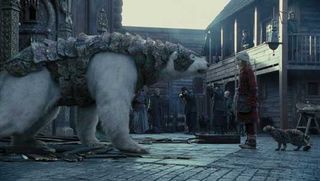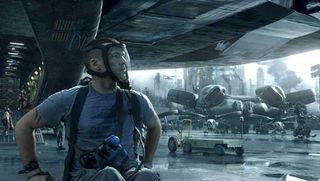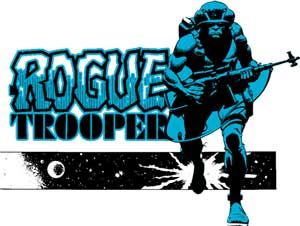It may have been the least surprising win at this year's Oscars. But Framestore's victory in the best visual effects category for Gravity is still hugely deserved. While we still tend to think of visual effects as 'add ons' to near-finished films, most of Gravity was created from scratch by leading VFX house Framestore using pixels alone; in many scenes only the actors' faces are 'real' (yes, even those spacesuits were digitised - see this article for details). And the result: a wild 3D ride in which the sensation of floating in space is at times overwhelmingly immersive.
The critical and commercial success of Gravity has led to a sea-change in attitudes towards the possibilities offered by stereoscopic 3D - the idea that it's just a 'gimmick' is fading fast - and it will clearly go down in movie history as a landmark release. But that's nothing new for the British firm, which has been a key innovator in the digital space ever since it was founded in 1986.
Digital pioneer

Having pioneered digital filmmaking right at the start - along with the Computer Film Company, which they eventually merged with - Framestore's portfolio is breathtaking, taking in everything from Harry Potter to The Golden Compass to Avatar, as well as less obviously effects-laden films as Notting Hill (remember that 'changing seasons' stroll through the market?).
And the company's stellar reputation was confirmed once more last night when it won the 2014 Oscar for Best Visual Effects for Gravity, completing the trio of top VFX honours alongside its Bafta and VES gongs.
But if there are laurels waiting to be rested upon, they're going to stay uncrumpled for some time to come. Co-founder and CEO William Sargent says they can't relax for a second.

"It's never been easy, and it's never been more difficult," he stresses. "We're in a very competitive industry. If we don't reinvent ourselves and do better next year than we did this year then we won't be around in three years' time. And if you want to be world-class and global then you cannot stand still."
That might be bad news for the hard-working VFX specialists at Framestore but it's great news for the public, because it suggests that a new generation of imaginative, innovative and exciting movies are about to come our way.
Get the Creative Bloq Newsletter
Daily design news, reviews, how-tos and more, as picked by the editors.
"Right now my focus is on: what's the new innovation we're doing, what's the new technology we're developing, what's the new project I can get excited about?" says Sargent. "And they're all out there. And for me I think we're at the beginning of, certainly a decade if not 20 years of new storytelling, coherently across different platforms."
Cut-throat competition
And by that he doesn't mean just new stories, but a whole new way of enjoying them. "At the moment stories tend to be told on a single platform," he explains, "whether that be a film, a television program, a computer game or an iPad app. But for me we're only beginning to tell stories simultaneously, across different platforms, in a non-linear fashion.
"Someone who's already directing and writing in the industry is going to crack that," he predicts. "And I hope that we are the people who are partnering with that person and that person is within our system here.
"I've no idea who it is, which country they're in, but we are only just starting an exciting time in our industry as far as I'm concerned. I couldn't tell you what it'll look like in five years. But I think we're as well placed as anyone else to succeed creatively in that space."
New ways to tell stories

One of the important words in that sentence is "creatively". Because although Framestore is feted for its technical prowess, it's not interested in technology for technology's sake. So, for example, stereoscopic 3D shouldn't be an end in itself, but a tool that should only be used when appropriate. "James Cameron applied stereoscopic to Avatar in a fabulous way," Sargent says. "He used it for the story, it was relevant, he used it in a very subtle way, as opposed to bits coming out of the screen.
"Gravity was the same. But in between we've seen occasions when 3D was not appropriate, or well executed. So like most things it's just a tool. Using computers to make films, which we started doing 27 years ago, was just a tool, in the same way that word processing is just a new way of writing. It doesn't change the way you write, or the things you write about."
The same applies for newer techniques, such as ultra-high resolutions and faster framerates - they have to be relevant. "So with 4K, 64 fps, I haven't yet been convinced that: 'Wow, this is the only way to do things'," continues Sargent. "But there will be a context in which it is the right thing to do. That was one of the things with Gravity that was very satisfying, that all the studio heads said to me: what it really did was remind people why stereoscopic 3D could be so amazing."
The script comes first
So for Framestore it's a clear case of putting the cart before the horse. "People say: 'Tell me what you can do technically, and I'll write the script'. But I reply: 'No, no, no! You write the script and then we'll think about how the hell to do it'," Sargent explains.
"That's exactly what happened with Gravity. We were asked to do zero G, and we thought 'Oh shit, how do we do that?' We looked at all the examples and none of them looked right. But we solved the problem. All the visual effects are there to tell a story. What you use, the technique you use, is the one that tells the story best."
Multiple possibilities

As he mentioned earlier, Sargent reckons the future of filmmaking lies in finding new ways to tell those stories. "The idea that you could change the storyline in real time, and then re-render it, like you do in a game, that must be something that will apply to filmmaking at some point," he enthuses. "We'll start seeing things like multiple endings and being able to stream to people's home cinema different versions of stories.
"If you remember some years ago how magazines started bringing out different covers for the same editions, the same thing will happen with movies," he predicts. "You could get different variations or different cuts - you might get the character reemphasised in one cut over another. Or you might be able to later go and see the back story of that character.
"So as I say, the whole creation of content and the access to and manipulation of it, we haven't even begun to think about how we do that. And then the tools you need to do that, obviously, are ones that have yet to be developed."
Clearly Framestore intends to be right there at the heart of the storm. And we can't wait to see the results.
Win a trip to Los Angeles!

Masters of CG is a competition for EU residents that offers the one-in-a-lifetime chance to work with one of 2000AD's most iconic characters: Rogue Trooper.
We invite you to form a team (of up to four participants) and tackle as many of our four categories as you wish - Title Sequence, Main Shots, Film Poster or Idents. For full details of how to enter and to get your Competition Information Pack, head to the Masters of CG website now.
Enter the competition today!

Thank you for reading 5 articles this month* Join now for unlimited access
Enjoy your first month for just £1 / $1 / €1
*Read 5 free articles per month without a subscription

Join now for unlimited access
Try first month for just £1 / $1 / €1

Tom May is an award-winning journalist and editor specialising in design, photography and technology. Author of the Amazon #1 bestseller Great TED Talks: Creativity, published by Pavilion Books, Tom was previously editor of Professional Photography magazine, associate editor at Creative Bloq, and deputy editor at net magazine. Today, he is a regular contributor to Creative Bloq and its sister sites Digital Camera World, T3.com and Tech Radar. He also writes for Creative Boom and works on content marketing projects.